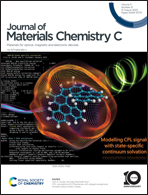NaCl-treated multiple carbon coating BaTiO3 nanoparticles towards enhancing dielectric properties†
Abstract
Polymer-based dielectric composites have attracted extensive attention due to their wide applications in electrical systems. Herein, NaCl-treated multiple carbon coating BaTiO3 nanoparticles (BT@N-CX NPs, where x represents the number of carbon-coating layers) were developed to regulate the carbon–shell thickness and optimize electrical properties to obtain excellent dielectric properties. A large dielectric constant (18.78@100 kHz) was observed along with a low dielectric loss (0.048@100 kHz) for BT@N-C4 NPs at a content of 10 wt% in poly(vinylidene fluoride) (PVDF), which was about 2 times higher than that of the PVDF matrix (9.45@100 kHz). It was found that the graphitization of carbon shells improved after the NaCl treatment, attributed to the fact that NaCl as a nanoreactor inhibited the diffusion of disordered carbon atoms during the carbonization. Thus, the energy barrier of charge transport and electron hopping was reduced, resulting in a large charge flux and high polarization. The optimal carbon coating thickness was regulated to obtain an appropriate carbon content and larger interfacial polarization. Besides, the decrease of dielectric loss was due to the optimized charge transport paths, that is, the charges migrated on the surface of the carbon shell to avoid the formation of a conductive network. This work provides a novel design route for polymer-based composites to obtain a high dielectric constant with suppressed dielectric loss.



 Please wait while we load your content...
Please wait while we load your content...